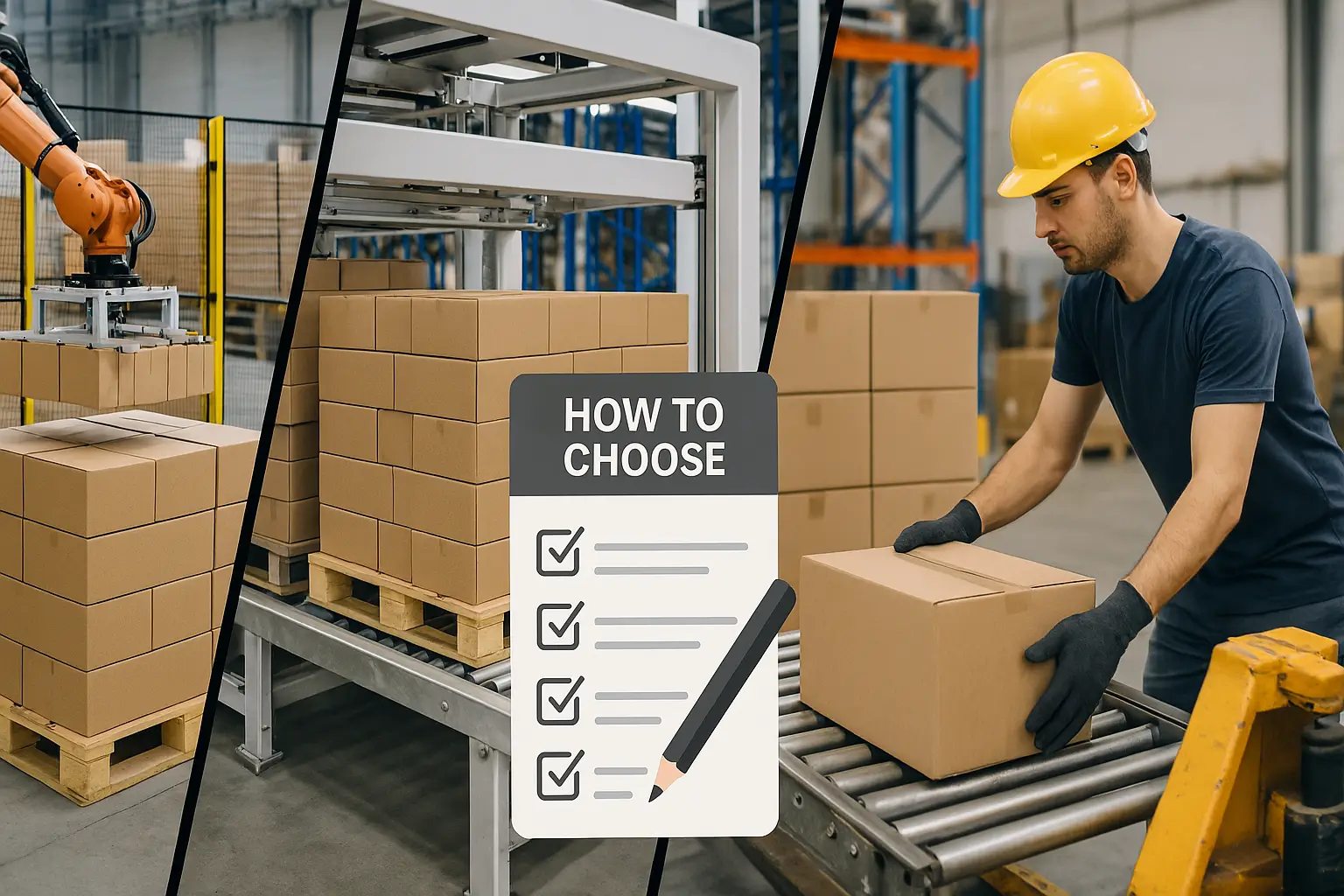Choosing the best palletizing system for your operations is crucial. It affects efficiency, safety, and your profits. Automation is growing in manufacturing and warehousing. So, knowing all about palletizing solutions is now more important than ever.
Understanding the Palletizing Landscape
Types of Palletizing Systems
Palletizing solutions fall into two main types: conventional palletizers and robotic palletizers. Each type has its own variations.
Conventional palletizers come in two primary types: low-level and high-level. Low-level palletizers work with products from floor-level conveyors. They align and rotate these products to form neat rows. This is done based on the chosen pallet setup. High-level palletizers work differently. They raise or lower the pallet to align with stationary product layers. This changes how the stacking process is done.
Robotic palletizers use human-like robotic arms. They pick up products and place them on pallets accurately. These systems use grippers or vacuum tools to move products. They are very good at handling large amounts. The robotic palletizing category now includes collaborative robots, or cobots. These robots are made to work with humans in shared spaces.
Gantry palletizers, or Cartesian palletizers, are a flexible automated solution for many uses. They work a bit slower than robots, but they offer flexibility. This makes them great for end-of-line tasks with low to medium production levels.
Hybrid solutions that mix conventional and robotic technologies are growing in popularity. Businesses want to cut down on secondary packaging but still keep efficiency.
Assessing Your Specific Requirements
To choose the best palletizing system, start by assessing your needs and limitations.
Product Characteristics
The nature of your products significantly influences which palletizing system will work best. Consider these factors:
- Product Dimensions: Size and shape are key when choosing a palletizer. Some systems work best with standard-sized items. Others can manage different shapes.
- Weight: Your products’ weight impacts the strength and capability of the palletizing system. Heavier loads may require more robust solutions with higher payload capacities.
- Packaging Type: Different palletizers work better with certain types of packaging. Cartons require a different setup than shrink-wrap or fragile items like glass bottles.
Production Requirements
Understanding your needs is crucial. It helps you choose a system that meets your current and future requirements.
- Throughput Speed: Calculate how many units need to be palletized per hour or per day. High-speed production lines need advanced, quick palletizing systems. This includes robotic and automated solutions.
- Flexibility is important. If you manage many products or expect changes, a flexible system is essential. It should adapt to different configurations easily.
- Future Expansion: Consider future production growth when selecting a system. Investing in a palletizing system can help you manage more products. This way, you might avoid upgrading too quickly.
Key Selection Criteria
Speed and Efficiency
The speed of a palletizing system affects your production capacity. Different systems offer varying levels of efficiency:
- Robotic palletizers work well at high speeds. They can boost throughput rates much more than manual palletizing.
- Conventional palletizers work best at very low or very high speeds. It all depends on the application.
- To evaluate speed, look at the average outbound rate. This gives a clearer picture of real performance than just the peak machine rate.
Maintenance Requirements
The ongoing costs of a palletizing system depend a lot on how much maintenance it needs.
- Some systems require more frequent maintenance schedules, which can impact overall operational costs.
- Think about replacement parts and the manufacturer’s support when you check maintenance needs.
- Automated systems usually need less maintenance than manual ones. This leads to cost savings over time.
Flexibility and Adaptability
As business needs change, it’s crucial for your palletizing system to adapt.
- Modular designs in palletizing systems let businesses customize palletizers to fit their needs. They can also add or remove parts as those needs change.
- Systems that handle various product sizes, weights, and shapes provide businesses with flexibility. This is especially useful for those with changing product lines.
- It saves time and reduces the need for extensive reprogramming.
Space Requirements
Your facility’s space can limit your choice of a palletizing system.
- Robotic palletizers need special stations for different case sizes or packaging types. This can affect how space is used.
- Conventional palletizers often have fixed footprints. These designs work best for new building installations.
- In tight spaces, compact solutions such as collaborative robots are often better. They fit into current workflows easily and need little reconfiguration.
Cost Considerations
Understanding the total cost of ownership is essential for making an informed decision:
- Initial costs for palletizing systems can vary a lot. Robotic arms for quick-ship palletizers start at about $100,000. However, more advanced systems can cost much more.
- ROI often favors traditional palletizing equipment at low and high speeds. In contrast, robotic systems may provide better returns for mid-range operations.
- Modern robot palletizers usually pay back in 12 to 18 months. This makes them affordable for mid-sized businesses.
Safety and Integration
Safety features and integration capabilities are crucial when picking a palletizing system. They are just as important as the main selection criteria.
Safety Features
Safety is key for palletizing equipment. These strong machines quickly move heavy cases and pallets.
- Palletizing equipment must meet OSHA and ANSI standards. Also, robotic systems have extra rules.
- Collaborative robots stop when they sense a collision. Safety depends more on the collision energy than on the force.
- Software settings are vital for keeping collaborative robots safe. Speed is a key factor in safety levels.
Integration with Existing Systems
Your palletizing solution must work seamlessly with your current operations:
- Make sure the machine’s programming and communication protocols work with your systems. This includes conveyor systems and warehouse management software.
- Connecting to Manufacturing Execution Systems (MES) can increase warehouse efficiency by 30%. This happens through improved coordination and optimized workflows.
- Think about if the system can work with IoT sensors. This would allow for real-time data tracking and help with predictive maintenance.
Conducting an ROI Analysis
Do a detailed Return on Investment (ROI) analysis before your final decision. This will confirm your choice from a financial viewpoint.
Identifying Costs
Start by analyzing your current costs related to manual palletizing or existing systems:
- Labor costs, including wages, overtime, and benefits for employees involved in palletizing.
- Error costs, such as damaged goods, customer complaints, and returns.
- Maintenance costs for current equipment.
Next, estimate all costs associated with acquiring and implementing a new palletizing system:
- Equipment purchase price.
- Installation and setup costs.
- Training expenses for operators.
- Ongoing maintenance and software updates.
Estimating Benefits
Calculate the potential savings your business could achieve with the new system:
- Labor savings from reduced staffing requirements.
- Increased throughput and productivity.
- Reduced product damage and improved stacking quality.
- Enhanced workplace safety and reduced injury-related costs.
Calculating ROI
The basic formula for ROI in palletizing investments is:
ROI = (Cost of Investment / Net Profit from Investment) × 100
Many businesses see a good ROI from automated palletizing systems in 12-18 months. This includes both direct and indirect benefits.
Step-by-Step Selection Process
To streamline your decision-making process, follow these steps when choosing a palletizing system:
Step 1: Define Your Product Requirements
Start by knowing the products you’ll handle. Check their size, weight, and packaging type.
Step 2: Assess Production Speed Requirements
Determine how many units you need each hour or day. Also, think about how much you might grow in the future.
Step 3: Evaluate Available Space
Check your floor space. Make sure your selected system fits well in your warehouse.
Step 4: Analyze Current Palletizing Process
List all products being palletized. Include their details like container type, size, weight, and speed. Check each pallet’s setup. Look at the number of layers, types of arrangements, and any special stability needs.
Step 5: Consult with System Integrators
Talk to skilled system integrators. They can evaluate your current process and suggest solutions that fit your needs.
Step 6: Compare Options
Palletizing Solutions Comparison Matrix
- Automated System A
- Speed: High
- Maintenance: Low
- Flexibility: Moderate
- Footprint: Large
- Cost: $$$$
- Semi-Automated System B
- Speed: Moderate
- Maintenance: Moderate
- Flexibility: High
- Footprint: Medium
- Cost: $$$
- Manual System C
- Speed: Low
- Maintenance: High
- Flexibility: Low
- Footprint: Small
- Cost: $$
- Robotic System D
- Speed: Very High
- Maintenance: Low
- Flexibility: Very High
- Footprint: Medium
- Cost: $$$$
- Custom Solution E
- Speed: Variable
- Maintenance: Variable
- Flexibility: High
- Footprint: Large
- Cost: $$$$
Step 7: Conduct ROI Analysis
Conduct a thorough ROI analysis. This will help you see the financial impact of your investment. Then, find out the expected payback period.
Useful Summarization Table
| Criteria | Conventional Palletizers | Robotic Palletizers | High-Level Palletizers | Low-Level Palletizers | Palletizing Software (UR & Pally) |
|---|---|---|---|---|---|
| Operation Principle | Forms layers on a squaring plate; drops layers onto pallets | Uses robotic arms with customizable end effectors for flexible handling | Builds layers from elevated infeed conveyor; faster and suitable for compressible products | Uses squaring plates; handles medium speeds; suitable for flat layers | Software solutions for programming and optimizing robotic palletizers |
| Load Types Handled | Bags, boxes, trays, bales, components | Boxes, drums, mixed loads, less rigid items | Bags, boxes, trays, crates; ideal for flat, stable layers | Similar to high-level but with slightly slower speed | Handles multiple SKUs, adaptable to new products without extensive reprogramming |
| Flexibility | Limited; designed for specific patterns and loads | Highly versatile; handles multiple SKUs and load types | Less flexible; optimized for high speed, uniform loads | Moderate flexibility; good for medium speeds and flat layers | Very flexible; easy product and pattern changes without downtime |
| Speed & Throughput | High for specific, uniform loads; limited for mixed SKUs | Generally slower but handles complex, mixed loads efficiently | Very fast, produces stable, flat layers | Slower than high-level, suited for medium speeds | Depends on robot and software; optimized for efficiency and adaptability |
| Space Requirements | Larger footprint due to conveyor and layer-forming mechanisms | Compact; integrates easily into varied layouts | Requires space for high infeed elevation | Smaller footprint; suitable for medium-speed applications | Varies; software can be integrated into existing robotic systems |
| Maintenance & Cost | Mechanical parts; routine maintenance; lower initial cost | Slightly higher maintenance; higher initial investment | Low maintenance; high speed and stability | Moderate maintenance; good for medium throughput | Software cost; enhances robotic system performance and flexibility |
| Integration & Automation | Customization needed; less adaptable to system changes | Excellent for system integration; programmable and adaptable | Easier to integrate with high-speed conveyor systems | Moderate integration; less flexible than high-level robotic systems | Critical for optimizing robotic palletizer operation and pattern changes |
| Best Use Cases | Stable, uniform loads, high-speed applications with fixed patterns | Diverse loads, SKUs, complex patterns, flexible operations | High-speed, stable loads, flat-layer palletizing | Medium-speed, flat-layer loads, applications requiring stability | Dynamic product lines, frequent pattern changes, multi-SKU handling |



Leave a Reply